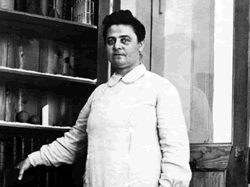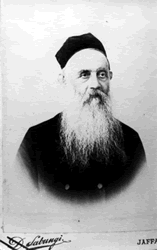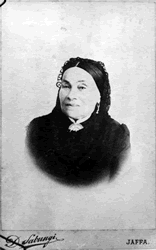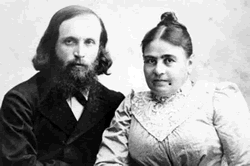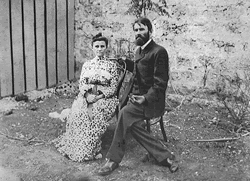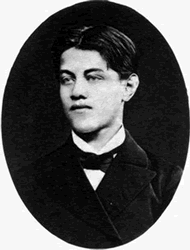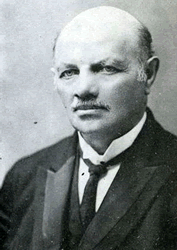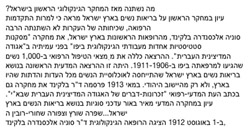Belkind Family
1. Dr. Sonia Belkind
2. Meir Belkind
3. Shifra Belkind
4. Olga nee Belkind (with husband Yehoshua Hankin)
5. Fanny nee Belkind and husband Israel Feinberg.
6. Shimshon Belkind
7. Israel Belkind
Pnina Belkind, daughter of the founder of Rishon LeZion; M. Freiman
was born in Warsaw, Poland in 1870. When she was 12 years old, she
immigrated to Eretz Israel with her parents - Rishon Lezion's founders
(1882). She atended the elementary school ("Chaviv") in the Township.
She was able to speak several languages. She was an avid reader.
When she married Shimshon Belkind, she built her house in Rishon
Lezion, but soon, upon the Baron clerks' injunctions the two left to
Gedera where their first two children are born.
Upon their return to Rishon Lezion, Pnina Belkind was carrying the
hard burden of their keep. She was working in agriculture and also
assisted in the work at the family hotel "Ein Hakore" that was opened
at her home.
During World War I, following the Nili affair, she was arrested along
with her husband and was transferred to the Ramla prison. However,
towards the end of the war, when the front approached Rishon Lezion,
the Turkish soldiers retreated to the Township and many of them
arrived at the Belkind's yard; she then cared for them devotedly and
fed them with the soup, prepared for an emergency. Later, when to the
Township came from the Galilee, malaria sick guys, she treated them
and gave them shelter in her house. She did the same with the
volunteers of the Hebraic regiments; she accommodated them at her home
and fed them.
Shimshon Belkind was born in Llhawisk, district of Minsk in Belarus.
He studied Jewish studies with his father and went on to study in the
Russian High School in Mohilev. When in 5th grade he moved to St.
Petersberg with a view to studying pharmacy and worked as an
apprentice in the Royal pharmacy.
When his brother, Israel Belkind, established the "Bilu" movement,
Shimshon terminated his studies and in 1882 came to the country and
joined the group of "Biluim" that were living in the Anton Ayub house
near Jaffa. He worked together with them in Mikve Israel until the
group left in 1884. He moved to Jerusalem and joined the Biluim group
"Shehu" there whose aim was to teach its members a trade and he learnt
carpentry and ironwork. When he sickened some months later he left the
group and moved to Rishon Le Zion.
Here, together with others, he revolted against the Baron's officials
and he was extradited from the village. He settled in Gedera and
became a farmer with his own farm. When the extradition order was
cancelled he sold up his farm and together with his wife andthe
British completed the conquest of the country Shimshon Belkind and his
son Ethan travelled to Damascus and brought back the bones of Naaman
and of Yosef Lishansky for re-interment in Rishon Le Zion.
During the riots of 1936 his son Meir was murdered. Despite the blows
he suffered during his lifetime he played an active role in public
service. He was a member of the first community centre committee and a
founder of the reading evenings programme. He was a member of the
orchestra, for many years a member of the village committee and a
member of the farmers? committee and a signator to the deed for the
establishement of the Rothschild Museum. In l921 he was the chairman
of the village committee.
In this year there were many important achievements: an official
government post office was set up in Rishon Le Zion; a special
official was appointed for the collection of the village taxes and
decisions were taken on taxing those bringing in goods to the village
market; rulings were established for official local electionsand the
flour mill which was in need of repair and had for some time been out
of use was repaired and put into use.
His father:Belkind Meir
Born: 1827
Birth Place: Belorussia (Belarus), Minsk
Immigrated: 1887
Departed: 1889
Departed to: Yafo
Died: 1898
Buried: Israel, Rishon Le Zion
His mother: Shifra Belkind
Born: 1830 to Shimon Dov Glastock
Birth Place: Russia
Immigrated: 1887
Departed Rishon Lezion: 1889
Departed to: Yafo
Died: 1910
Other children of Meir and Shifra;
Olga Hankin, the eldest daughter of Meir and Shifra Belkind, was born
in Leheusek, Minsk region, Russia. Her teacher who was her father, the
owner of a revised "Cheder", taught her Hebrew, Bible, Mishnah, and
Talmud.
After graduating high school, she wanted to continue her studies at
the St. Petersburg University but staying in the capital was forbidden
to the Jews, apart from those who had needed professions. However,
ambitious Olga turned to the telegraph operator at the postal office
in her hometown and learns from him the profession. Due to this
occupation, she gets a permit for residence in Petersburg. Here, she
is the first Hebrew student who learns in the course of midwifes at
the university, aiming to continue studying medicine. She also brought
there her brother and sister so that they could continue their
studies.
Her home in Petersburg was the center of Jewish writers and students
as well as of Russian intellectuals and revolutionists and she is
among the first to raise the Zionist and the "Bilu" ideas even before
the riots ("Storms in the Negev") of the year 1881.
When the "Biluim" left, on their way to Eretz Israel, on the summer of
1882, she published in the "Melitz" an enthusiastic letter of
encouragement in Hebrew:" ... Go brothers, use your strength and act
in favor of your people, a contemptible and seditiousness nation;
strengthen your hands; don't let your heart to get soft; be strong; be
the pioneers of our brothers' army and your names will be a blessing
to the last generation; you outdid yourself in your first step. ( M '
Smilanski, the family of the land, volume B ' page '134).
ln the year 1886, she immigrated to Eretz Israel, to Rishon Lezion,
leaving behind her dreams about studying. When a year later, the
settlers' revolt against the Baron Rothschild's clerks broke out and
during the Baron's visit to the settlement, Olga Hankin participated
in a women's delegation to the Baroness; thanks to her appearance and
her impressive words, the Baron's wife tried to soften her husband's
position towards the members of Rishon Lezion. As the decree of
deportation against her rebelling family was final, she influenced
them to give it up for the good of the community and resettle in
Gedera.
In the year, 1888, she married Jehoshua Hankin and they established
their home in Jaffa.
Since then, she granted a crucial contribution to the "Hankinian" enterprise.
As an expert midwife, she had good connections to honorable Arabs and
due her influence they agreed to sell land. Every morning Olga, riding
a white donkey used to leave home and extend her help as midwife and
medical assistant to Arab and Jewish women of the city. In the evening
acquaintances and friends used to come to the house and together plan
their activities of redemption of land throughout Erertz Israel.
During 1890-1891she influenced rich Arabs to lend her husband the
first amount of money to purchase the land of "Emek Izrael" and
convinced Dr. Tiomkin to give his consent to the redemption of the
valley. Later on, when the decrees of the Turkish authorities caused
to thwart the deal and the money of the Jews in exile was left with
the sellers, she helped her husband to return the money to the buyers
while she and her husband suffer shortage and distress.
"At the first difficult days which the Hadera's residents underwent,"
writes M. Smilansky (p. 140) "days of attempts, of mishaps, of
internal strife, of discouragement - she was seen with her friend
Jehoshua coming up from the sea side, back horse riding beyond the
wadi "Chawarat", "... when she appeared, she pacified their shaken
feelings and strengthened their hearts " During other difficult days,
when her husband faced financial legal trials due to an entanglement
because land purchases which he carried out, Olga " again stood there
as a wall to support her whole family and as a solid rock to uphold
her friend Jehoshua. Again, she wandered around by foot or by riding
her donkey, between the Arabs and her medical advice seekers, and
talked to Jehoshua 's foes repeatedly, as a loving friend and admirer.
She strengthened his spirit and encouraged his soul, prophesying to
him: that the dark night will be over, that the gate will open again,
that his day will come, that he has been created for greatness and
that he has been destined to do unattainable deeds... (p. 141).
In the year 1915, Yehoshua Hankin was arrested at the command of Jamal
Pasha, for being a dangerous Zionist activist and was deported to
Turkey. Olga exiled voluntarily with him. When the First World War was
over, the two returned to Tel Aviv. Here she continued to assist the
operation of redeeming the land and often contribute to charity
enterprises.
When she died, she was brought to burial at the slope of Mount Gilboa
in a grave Jehoshua Hankin prepared for both of them, at location
overlooking the Valley "Emek Izrael" which was redeemed by them.
Fanny Feinberg was born in the district of Minsk in White Russia. She
studied with her father, Meir Belkind, who a teacher and head of the
(Amended) "Heder Metukan" and also at the school for girls in Borisov.
She was well versed in bible studies.
Later, she moved with her sister to Petersburg to continue her
education and studied pharmacology.
In 1882 she decided to join her two sisters who were members in the
"Bilu" group and in August of that year she arrived in Jaffa and
joined the Bilu group living in the Anton Ayub house. She later
expressed her enthusiasm for the revival of the Jewish people in its
homeland in an article in the "Hamelitz" newspaper. And this is what
she wrote to her sister in Russia: " …if you don't know yet how
wonderful life can be in the splendid looking fields and farmers'
homes, arise and come to join us to the Holy Land, inhale its holy
spirit in all its splendor at its mountains heights and valleys
depths. The idea that you are standing on the land of your forefathers
will make a new spirit swell up within you, something that our
brethren living in the Diaspora cannot imagine…"
She arrived together with her "Bilu" friends to Rishon Le-Zion where
she cooked and cared for the whole group. In addition to all this, she
also assisted the doctor with his work in the village.
After she married Israel Lolik Belkind, she moved to Gedera with him.
Like him, she acted bravely and forcefully towards the Arabs who would
attack her. She learned Arabic and it is said that she spoke it like a
true "Fellah" (Arab peasant).
In Hedera, where she moved with her family in 1898, she learned the
Arab system of farming, improved and passed it on to others –and was
nicknamed "Halutzat Hahalutzim" (Pioneer of the Pioneers), the teacher
of all the women settlers. Despite the hardships and cholera that took
its toll, she persisted and did not let her husband despair. After his
death, she continued to run the family farmstead. It was only after
the 1921 Arab riots that she left and moved to live with her daughter
in Tel Aviv.
Her last years were spent in Rishon Le-Zion and upon her death she was
buried in the city's old cemetery.
Israel Belkind was born in Lahuisk, Belarus in the Minsk region. He
studied Hebrew and Bible at home with his parents, enthusiastic lovers
of Zion: his father, Meir, who was one of the first Hebrew teachers in
the diaspora and his mother Shifra a literate person, who knew well
the Bible and spoke Hebrew with her children. He did his general
studies in Mohilev at the government's high school and at the
university in Kharkov.
Following the riots that occurred in Russia in 1881 ("The storms in
the Negev"), Jews woke up from their dream for a better future there.
Upon the initiative of Israel Belkind, in January 1882, an association
of youngster was established, which aimed to leave the Russian exile,
immigrate to Eretz Israel and work for the revival of the people and
the country. The name of the association was "DABIO" - Speak to the
people of Israel and they will travel.
After months of preparations, including the change of the group's name
to "BILU" – "The family of Jacob please go and we will (also) go"- ,
the first fourteen Bilu pioneers, led by Israel Belkind, arrived in
Jaffa and began work as agricultural laborers in Mikveh Israel. Later,
as per the Baron Rothschild's orders, they settled in Rishon Lezion
and their hut became the cultural and social center for the township's
youngsters.
Israel Belkind, the initiator of the idea of immigration to Eretz
Israel and the moving spirit in all activities of the initial group of
the Bilu pioneers, soon began to rebel against the Baron's clerk
attitude to the township's inhabitants. Signed by all residents, he
sent a letter to Paris with of complaints against the Baron's
representatives, the manager Hirsh and the gardener Diggor. As a
response, to this, he was expelled from the township and the all
residents - including his family – were forbidden to lodge him in
their houses even only for one night. It should be noted that despite
the desire of the Rishon Lezion's people to oppose his expulsion and
to prevent them from suffering, Israel Belkind voluntarily left and
moved Jaffa.
In Jaffa he knew hard times of hunger and lack of place to stay.
Sometimes, he walked in the darkness to his township Rishon Lezion to
stay there until morning, and was then walking back to Jaffa. With the
help of the Lovers of Zion in Odessa, a piece of land and a farm were
bought for him, in Gedera which was just founded by the Biluim, and he
became a farmer. But not for long. When being elected to the committee
of the Zion Lovers, founded in Jaffa, he saw here a wide scope for
activities for the development of the Jewish population in Eretz
Israel and - abandoned his farm. Israel Belkind returns to Rishon,
working in his brother's Shimshon farmstead, participating in the
cultural life of the township, organizing a children's choir and
teaching them the songs of Imber. In 1885, when the township reached
three years, a celebration was held initiated by him, during which the
first ever blue and white flag with the Star of David, was raised. A
few days later he wrote a letter to his friend Dubnov in which he
described Rishon Lezion, the a/m celebration and the flag, "and me and
Fanny Meyerowitz were busy in the meantime making a flag. This was a
flag that we did: a white cloth, two strips of azure at the two ends
of an azure Star of David in the middle ". ("Meyamim Rishonim",
magazine of the Resurrection in Israel, the editor A. Druyanov). Upon
the second outbreak of Rishon Lezion peasant's revolt against the
baron, his brother, Shimshon Belkind, was one of the rebels' leader
and had been expelled, as his brother before him, from the township
and again Israel was forced to leave the place. In the year 1889, he
founded a Hebrew school in Jaffa. When the school was closed due to
financial difficulties, in 1892, he was for two years, a school
teacher in the "Alliance" school in Jerusalem and wrote textbooks for
students. Later, he wandered about a year among Arab villages on both
sides of the Jordan, studied the country and its people, learned the
Arabic language, created a theory about the Jewish origins of the
Arabs and published the book "Eretz Israel Bazman Haze". In the year
1900 he returned again to Rishon Lezion and ran the first Hebrew
school ("Chaviv"). Along with his teachers he acted to revive the
Hebrew language and attended meetings of the teachers (preceding the
Teachers Union). A year later, he first conceived the idea of creating
"Kiryat Sefer" - being "a farming school in Eretz Israel" and that
differently from the agricultural school Mikveh Israel, which taught
in French and many of its graduates had not accomplished the tasks of
agriculture in the country. The purpose of the school "is to educate
the youth of Israel on the cultivation of land so they could live in
dignity from the toil of their hands". He henceforth devoted all his
time to realize that idea of his .To convince people of the idea of
establishing "Kiryat Sefer", Israel Belkind went to Russia and in the
year 1901; he submitted a proposal to the Zionist Congress and
received his consent, as well as Hertzel's agreement to establish an
agricultural school under his management. Following the riots that
occurred in Russia in 1903, Belkind gathered in Kishinev orphans,
children of the killed persons and brought them to Eretz Israel to
educate them to agriculture in his "Kiryat Sefer". The orphans stayed
in Rishon Lezion for three month, then moved to Shfeya and later – to
Ben Shemen. When the school was closed in 1906, he began working as a
clerk in the AFEC bank, wrote books about Eretz Israel, issued a
magazine called "Hameir" and worked as a school headmaster. On the eve
of World War I, he came up with the idea to bring a group of his
students to the Golan Heights to form a tribe of shepherds - settlers.
The idea did not materialize, however, affected the "Hashomer" people
who came to live among the Bedouins. During the war he came to
America, wrote in newspapers and authored the book "Hatzeadim
Harishonim" - the new settlements history in Eretz Israel. In the year
1920, he returned to Eretz Israel and began to dedicate himself again
to the idea of the school "Kiryat Sefer" in which he saw an essential
need for the resurrection of the people and country. Again he brought
to Eretz Israel in 1923, orphans of the pogroms from the Ukraine,
established for them an educational institution in Hadera and later in
Tzfat. Also this institution had been closed pretty soon because
Israel Belkind refused to allow the financing institutions to
intervene in the affairs of the school and those denied him the
necessary assistance. Belkind's students attested that he was a
beloved and successful teacher who used unconventional educational
methods. His students considered him as a father and the many letters
to him will attest to that effect (found in the museum archives in
Rishon Lezion, A 1-3 File 24).In 1928, he founded a publishing house
called "Hameir" to issue his writings "The Hashmonaim, or the War of
Liberty," "The Jewish War against the Romans", "Samaritans and Arabs
in Eretz Israel", "Where are the Ten Lost Tribes", "Eretz Israel at
this time ", a large map Eretz Israel and more. In 1929, Israel
Belkind became sick and traveled to Germany for medical treatment
where he died. Months later, in 1930, he was buried in the old
cemetery in Rishon Lezion.
Hankin Belkind Alexandra Sonia
Born: 1870
Birth Place: Russia, Minsk,
Immigrated: 1883
Arrived: 1887
Residence in the Village:
Occupation: doctor
Departed:
Departed to:
Died: 1943
Buried: Israel, Rishon Le Zion
Belonging to Group
The "Biluim" immigrant group
